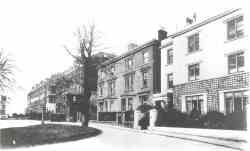Contents
Blackheath: A middle class estate of the 18th and early 19th centuries
by Neil Rhind
Flourishing Blackheath
By this time the residents of Blackheath were enjoying a busy Village that held the commercial, professional and light industrial providers needed to keep the inhabitants of a middle class suburb in food and raiment and other necessities. It is of interest to note that the railway did not encourage the core growth of Blackheath Ė it came in 1849 after the little town had been flourishing for some years. Such was the tenacity for the rural quality of the local environment that the residents and landowners forced the railway engineers to place their metals in the least obtrusive manner possible. It is of interest today (2002) to note that the railway does not split the community and that many cross it daily without realising they have done so - despite very little of it being in a tunnel.
West Grove, Blackheath, c. 1905By the early decades of the 19th century the inhabitants had cried: "enough!" They did not wish the manor holders to grant any further encroachments on Blackheath, either for building plots or for turf cutting, gravel digging, lime burning or rubbish dumping. The Heath was by then an important part of the social fabric of the residents. Organised sport had been largely codified and arranged by Blackheath teams; the golf club was not only the first ever in England but remained supreme and almost alone in the country until the later decades of the 19th century. Cricket saw a dozen tables laid down by the early 1820s; football (of various rulebooks - or none) was played by boys attending the numerous private schools that had opened in the district. Schools made a substantial impact on Blackheath. They occupied many of the larger mansions that had fallen out of fashion or were in poor repair: Dickenís Creakle Academy (David Copperfield) was set on Blackheath, probably West Grove.
The football enthusiasm was to reach its apotheosis with the foundation of the mighty Blackheath Football Club in 1862 Ė still playing, perhaps the oldest open football club playing the Rugby Union rulebook. On a lesser social plane there were regular athletic meetings, racing, pedestrianism and other mass spectator sports that attracted drink booths and betting on a large scale.
One curiosity of the time came in 1801 when John Julius Angerstein enclosed a large section of Blackheath on its north east side: the ground facing Shooters Hill Road from the corner of Vanbrugh Terrace to Sun Lane and bounded on the north by the Old Dover Road and Vanbrugh Park. Angerstein (1735 - 1823) claimed that he had no knowledge that he was doing anything wrong and offered to compensate the parishioners of Greenwich for his trespass for the sum of £10 a year. The Parish (foolishly) agreed and the ground was lost forever, although the actual developments were not to rise until 1839 - 1840. The first buildings were Nos 7 - 29 Shooters Hill Road, a fine group of seven blocks of 14 semi-detached houses.
The land gave space eventually for St Johnís Park and its attendant feeder roads. In 1871 the Heath was taken into public care to be protected for the benefit of the people of London in perpetuity, the freeholders retaining only rights of soil. By 1880 the last great estate, Westcombe Park, on the northeast side of the Heath - was being carved into countless building plots and the development of the Blackheath suburb was complete.
